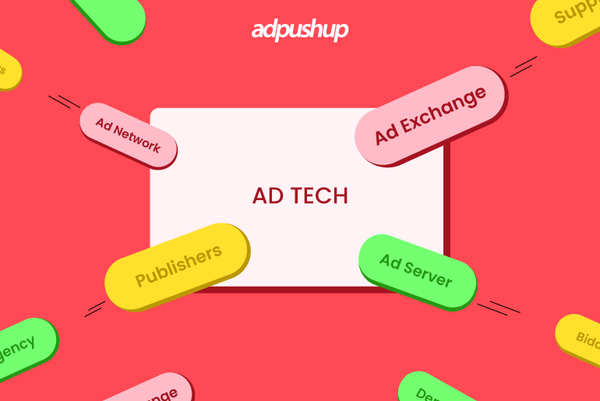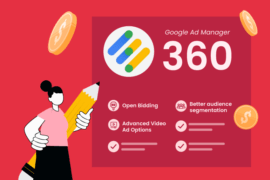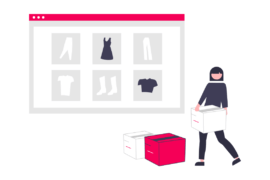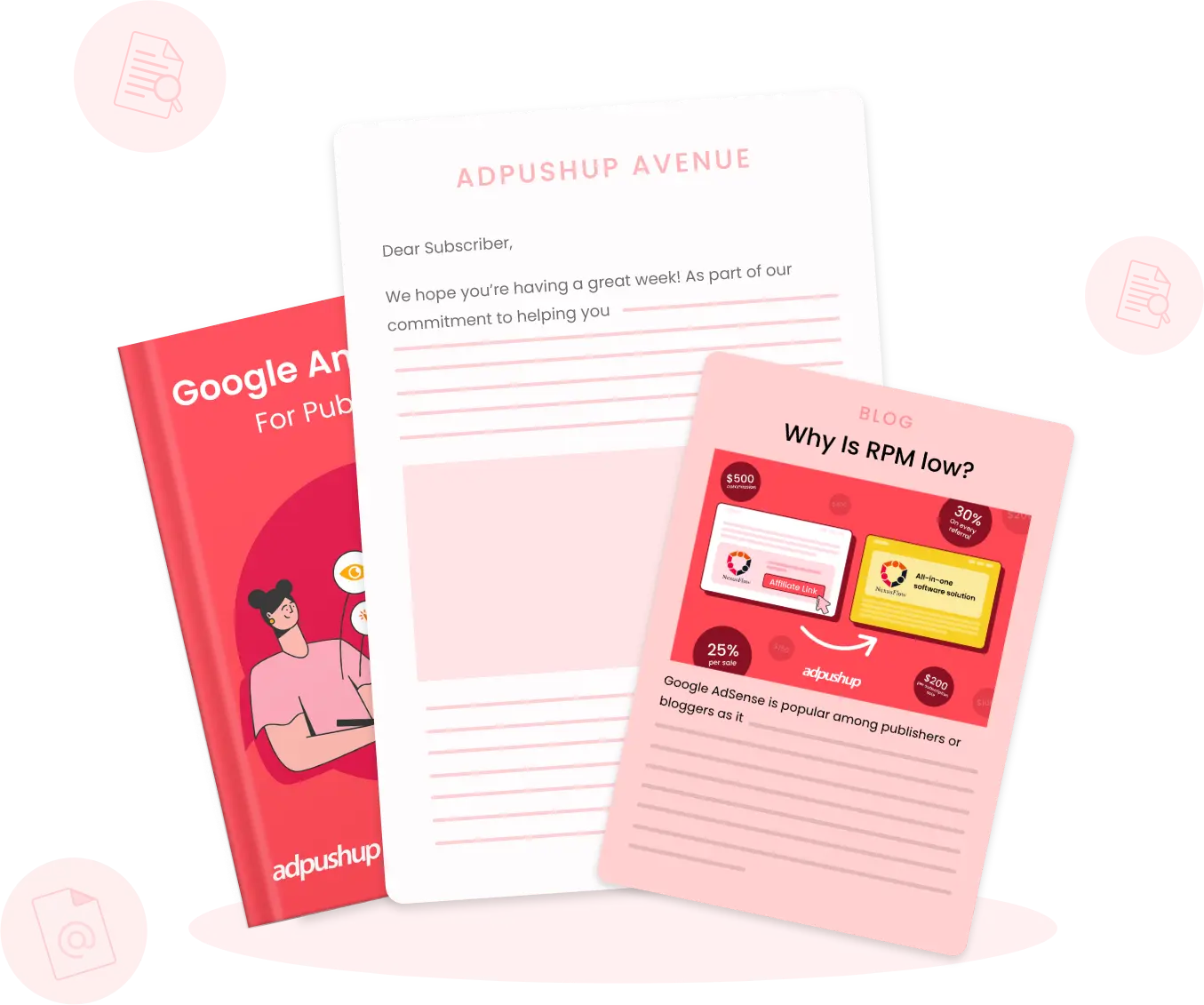Delve into the world of adtech: uncover its perks, best solutions, and industry trends.
The adtech industry is set to grow from $438bn in 2021 to $1 trillion in 2030, according to GlobalData.
While the Adtech industry is growing rapidly, many young ad agencies, publishers, and content creators are still trying to figure out what exactly adtech is – and how they can best use it to their benefit.
In this blog, we’ll deep dive into what is adtech and how adtech works for publishers and advertisers. So without further ado, let’s get started with adtech meaning.
What is Adtech (adtech definition)?
According to adtech definition, adtech or advertising technology is an umbrella term for the tools and software that help brands target, deliver, and analyze their digital advertising efforts.
It eliminates the need for publishers and advertisers to be present physically for the ad bidding by employing digital tools such as programmatic advertising, Demand Side Platforms (DSPs), Supply Side Platforms (SSPs), ad servers, ad inventory, and so on.
Not only does adtech streamline the execution of ad campaigns, but it also optimizes the websites (including user experience and ad strategies) for maximizing ROIs.
What is Adtech Industry (adtech 101)?
The adtech industry eliminates geographical constraints, enabling advertisers and publishers to engage in ad bidding processes through advanced digital mechanisms. These mechanisms include, as mentioned earlier – programmatic advertising, Demand Side Platforms (DSPs), Supply Side Platforms (SSPs), ad servers, and sophisticated ad inventory management systems, among others.
In the adtech space, adtech isn’t solely focused on campaign execution; it’s a driving force behind website optimization strategies. These strategies encompass enhancing user experiences and fine-tuning ad placement methodologies to create more effective advertising strategies that ultimately maximize Return on Investment (ROI).
Additionally, the adtech landscape continually evolves, integrating emerging technologies and methodologies to further refine and optimize digital advertising practices.
That said, let’s now talk about one of the subsets in the adtech ecosystem, which is programmatic adtech.
What is Programmatic Adtech?
As the name suggests, programmatic advertising, also referred to as the programmatic display, is a set of algorithms that automatically purchases and sells digital ad inventory.
It manages a range of functions, from setting the floor price and designing ad format to generating reports on performance and creating a bidding proposal to facilitate real-time bidding (RTB). It eliminates the need for any middleman or ad fraud as the whole process is automated.
Benefits of Programmatic Advertising
- Elimination of manual selling and buying of ads
- Automated processing makes buying or selling fast and efficient
- Easy segmentation of the audience is beneficial in targeting and retargeting
- Access to a wide range of suppliers and advertisers
- Access to comprehensive performance reports
What is an Adtech Company for Advertisers and Publishers?
Adtech includes various technologies to assist advertisers, media agencies, and publishers in successfully running advertising campaigns. It includes:
1. DSP: demand-side platforms
Demand side platforms are usually designed for advertisers to bid on ad space or inventory available on the websites of a variety of publishers. It programmatically connects the advertiser to the right kind of users at the right time by placing their ads on the websites, which will drive massive traffic or the highest impressions.
It deploys real-time bidding technology and can provide advertisers access to the integrated inventory of publishers. It is essential for DSPs to know which channel to focus on; it can be mobile or desktop.
2. SSP: supply-side platforms
Simultaneously working with DSPs are supply-side platforms, also known as sell-side or yield optimization platforms. Publishers use these platforms to offer up the ad inventory to the advertisers and ad networks at the highest possible bid for an ad impression.
It follows the simple fundamentals of the economics of demand and supply; whereas demand for ad space increases, the value of suppliers’ or publishers’ ad inventory also increases.
Note: DSP and SSP work simultaneously without any intrusion of intermediary, further reducing the cost and the risk of ad fraud. DSP allows advertisers to assess the ad inventory of suppliers or publishers to bid on the digital real estate offered by publishers for the lowest price, while SSP connects the publishers to advertisers with the highest bid.
3. Ad exchange
Apart from the Demand side and supply side platforms, the vestibule between publishers and advertisers is ad exchange which facilitates the easy and real-time ad space auction.
Types of ad exchange:
Ad exchange can be bifurcated into two different categories:
Open ad exchange
The open ad exchange is a platform that is open to all sellers and buyers.
Private ad exchange
The private ad exchange, which falls under PMP adtech (Private Marketplace Adtech) is a marketplace that requires invites for selected buyers and sellers who connect for private programmatic auctions.
Note: Ad exchange is not to be confused with an ad network. Contrary to the ad network that connects the advertisers to various websites for fixed-price ad space, ad exchange determines the price in real-time bidding.
4. Ad server technology:
Besides the major players (DSP, SSP), another one in the world of advertising is ad server technology which is a reservoir of ad creatives using particular software to place ads on websites as and when required.
With its ability to optimize the ads post analyzing the massive amount of data collected from first parties and third parties, it displays ads as per the user’s relevance.
The publishers and advertisers filter the ads served based on the target audience, ad format, and demographic attributes. Ad servers also keep account of the frequency of the ad shown to the particular user.
There are two types of ad servers used both by publishers and advertisers. Publishers employ first-party data ad servers while advertisers use third-party ad servers.
How does it work?
- The first step is always landing on the website. While the website loads, the ad tags start loading as well.
- A user’s visit to a website enables an ad publisher’s server to analyze user data and immediately send the ad request to publishers.
- This process is followed by an ad server sending requests to ad exchange which connects the buyers to bid for ad space relevant to users.
- Since the ad server measures the frequency of the ad displayed, if the particular ad is displayed too many times, it runs the risk of being turned down.
- The buyers’ requests are processed in less than a blink’s time, and the selection of the best bid takes place.
- Finally, after the fetching of ad creative, it is downloaded onto the website.
Note: This process is performed in under one second to register high viewability.
5. Ad networks
Another most used technology is an ad network. It is a system that integrates ad inventories of suppliers or publishers to be offered to match the buyer’s demand.
Ad networks act as intermediaries between the demand side and supply side platforms. Ad networks make the monetary negotiations less cumbersome as prices for the inventory are mostly decided. Also, it helps in managing the ad campaigns executed by the advertisers.
6. Agency trade desk
ATD is software including services related to media planning and buying provided by the media agencies. Working in hand with DSPs, ATD provides assistance to advertisers’ bidding and ad space purchases. It typically employs a team of software developers, data analysts, and account managers on behalf of clients.
7. Content Delivery Network
Content delivery networks are the around-the-corner copy ad servers that transfer ads from one place to another to provide higher availability and performance to end-users. These networks are distributed geographically. In other words, they provide content from locations nearby to the user to reduce the bandwidth time, accelerate performance, and give users a better user experience, further reducing site abandonment.
What are the Benefits of Adtech?
Now that we have talked about exactly what adtech is, and how it works, let’s shed some light on some of its benefits.
It is Time-Efficient
In the fast-paced world of digital advertising, time is a precious commodity. As a publisher or an advertiser, we constantly juggle multiple campaigns, analyze data, and refine strategies. This often leaves us with limited time to focus on the truly impactful aspects of our work.
However, the advent of adtech has revolutionized the way we operate. With its help, we get to eliminate the daily repetitive tasks that we might have been doing as a publisher or a buyer. This lets us save time and resources, transforming our daily routines and propelling us towards greater efficiency.
It offers Higher ROI
Though adtech helps you save time and resources, perhaps one of the most compelling advantages is its ability to enhance your return on investment (ROI). In the world of advertising technology, there are myriads of campaign tracking and measurement tools.
These tools provide you with valuable insights into the performance of your publishing and advertising efforts. Armed with this data, you can make informed decisions to optimize strategies, refine targeting, and allocate your ad spend more effectively.
It Helps Reach Your Ideal Customers
Reaching your ideal customers is paramount for revenue generation. Utilizing adtech, especially demand-side platforms (DSPs), enables the implementation of highly targeted campaigns.
On the flip side, supply side platforms (SSPs) help publishers maximize their ad inventory by connecting with advertisers seeking to reach specific demographics or segments.
When these two components work in harmony, DSPs and SSPs facilitate a streamlined exchange. DSPs ensure your ads are presented to the right audience, while SSPs enable publishers to effectively monetize their inventory by connecting with advertisers seeking precisely what they offer.
Adtech vs. MarTech: The Difference
Adtech, a buzzword in the digital world, is a term that surrounds technologies like ad networks, ad exchanges, ad servers, header bidding, and so on, all focused on optimizing ad revenue and ad delivery for better website viewability and brand recognition. It also acts as a weapon against digital media world challenges of privacy, ad fraud, and ad block.
Adtech companies reach customers via paid channels utilizing user insights.
Martech or marketing technology is the strong contender that reaches the audience using unpaid channels or the brand’s first-party data. Its main aim is the smooth execution of marketing strategies to manage marketing campaigns through emails and social media accounts.
Here is how they differ from each other in a nutshell.
| Aspect | MarTech | AdTech |
| Focus | Optimizing and streamlining marketing efforts | Buying and selling ad inventory space |
| Objective | Automating, optimizing, and measuring campaigns | Managing and executing advertising campaigns |
| Core Functionality | Tools for campaign automation, analytics, CRM, etc. | Platforms for ad inventory management, targeting, etc. |
What are the Types of Adtech Solutions (adtech platform)?
Adtech comes with plenty of solutions, with each serving a different purpose for publishers and advertisers. Let’s have a look.
Online Advertising
Online advertising is one solution offered by the advertising technology, which empowers the implementation of online ad campaigns, ensuring adaptability across various devices your audience uses.
Utilizing digital adtech allows you to:
- Accumulate and analyze audience data
- Track the performance of your campaigns
- Customize ads to suit individual preferences
- Centralize the management of all ad endeavors
And the list goes on.
This technology facilitates the administration of an array of ad campaigns, which spans from pay-per-click (PPC) search engine ads to sponsored promotions on social media platforms and beyond.
Mobile Adtech
Mobile advertising technology is another powerful solution for creating ad campaigns tailored specifically for mobile devices.
With mobile adtech, you can:
- Collect and analyze audience insights specific to mobile users
- Monitor and assess the effectiveness of your mobile ad campaigns
- Customize ads to align seamlessly with mobile user behaviors and preferences
- Streamline the management of all mobile-focused ad initiatives
And beyond
This innovative technology empowers you to execute diverse ad campaigns optimized for mobile platforms, ranging from targeted mobile search ads to engaging promotions across various mobile apps and websites.
Video Adtech
Video advertising technology opens new avenues for dynamic ad campaigns tailored to captivating visual experiences.
With video adtech, you gain the ability to:
- Utilize engaging storytelling and visual narratives
- Maximize audience engagement through immersive formats
- Leverage advanced targeting for precise audience reach
- Track and optimize campaign performance with detailed analytics
This cutting-edge technology empowers the creation of diverse ad campaigns optimized for video platforms, from compelling brand stories to interactive and visually stunning promotions across a spectrum of digital channels.
Native Advertising Technology
Native advertising seamlessly integrates paid advertisements within the look and function of the media format they inhabit.
With Taboola, you can:
- Seamlessly match ads with the appearance and functionality of various media formats
- Expand your audience reach by integrating ads within content-driven experiences
Taboola’s innovative technology empowers advertisers to seamlessly merge their ads into media formats, enhancing the overall content experience for users.
Automated Bidding Adtech
Automated bidding adtech streamlines the bidding process by removing manual guesswork. Unlike manual bidding, there’s no need for constant bid adjustments across various ad groups, keywords, or budgets.
With this technology:
- Your platform automatically adjusts bids based on the likelihood of generating clicks and conversions, optimizing sales and revenue.
- You can set maximum bid amounts or budgets, allowing the software to manage the bidding process.
- Previous bid performance data informs future bids, enhancing overall campaign outcomes.
Key takeaways
- Adtech companies allow for successful management and optimization of advertising campaigns.
- Adtech basics include ad networks, ad exchanges, demand and supply platforms, and ad servers which form the core of adtech industries.
- Programmatic advertising is the automated form of advertising that facilitates ad inventory sales and purchases.
- An ad server is especially beneficial for agencies and advertisers if they directly connect with publishers and their websites.
Frequently Asked Questions
Adtech companies as business partners can be pretty promising. Below is the list of top adtech companies:
1. Adpushup
2. iClick Interactive
3. Moloco
4. Mintegarl
5. postclick
1. Improved efficiency of advertising campaigns
2. Optimum utilization of ad spend
3. Continuous performance report metrics for further improvements in content.
Agencies use:
1. Ad servers
2. DSP
3. Agency trading desks
4. Inventory scanning tools
Advertising is fraught with ad fraud and low-quality ads. Thus, adtech companies partner with inventory and ad quality scanning tools to overcome both earlier-mentioned threats.

Deepak has a keen eye for detail and a deep understanding of the ad tech landscape. Whether it’s through in-depth articles, thought-provoking insights, or compelling storytelling, he’s dedicated to helping people navigate the complex world of ad tech with the simplicity of his words.







